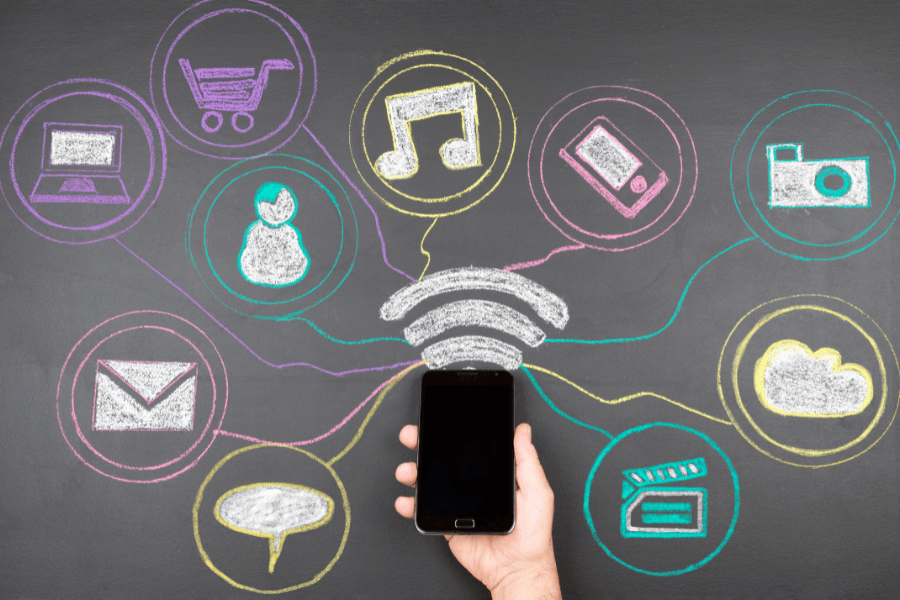Social media plays a massive part in many people’s lives, especially with teenagers. Studies show teens spend nearly five hours daily on social media platforms such as TikTok, Instagram, and YouTube.[1] Within those five hours, they are faced with images and ideas that may tempt them to use drugs and alcohol because of the way substances are portrayed. Residential treatment centers for youth near me address these concerns and strive to provide young adults with the tools they need to set healthy social media boundaries.
Continue after video
Impact of Social Media on Young Adult Addiction
When teens are on their favorite social media platforms, it’s easy to see celebrities and social media influencers glamorizing drug and alcohol use, making it appear a normal part of everyday life. They can see their favorite celebrities on Instagram or TikTok using substances, often with minimal consequences.
Besides seeing images of alcohol and drug use, platforms like TikTok can share viral challenges and hashtags that can quickly spread, influencing large groups of users to try different substances.[2] This can be particularly troubling for young people who can be influenced by these images. Research has found that teens who use social media are more likely to use marijuana, tobacco, and alcohol, compared to teens who are not on those social media platforms.[3]
Moreover, teens who use YouTube are faced with influencers and content creators who can sway their audiences towards certain activities, including drug and alcohol use. On Instagram, youth are faced with curated content that can normalize substance use behaviors and portray them as a desirable lifestyle.
Influencing their Daily Lives and Emotions
As teens see others using substances on various social media platforms, they may begin to feel like they are missing out. This fear of missing out (FOMO) can also tempt them to want to use substances to feel like they are part of the crowd.[4]
Besides the influence celebrities and influencers can have on young people, social media use can also make teens vulnerable to cyberbullying if they choose not to use substances. Other teens can find them online and harass them for their choice not to use drugs and alcohol. This may pressure them to try substances they otherwise rejected. These decisions can not only lead to addiction but can also cause anxiety, depression, and other harmful consequences.
Residential Treatment Centers for Youth Near Me on How to Set Boundaries for Social Media Use
With the ways that social media use can impact teens and substance use, parents and guardians need to help set boundaries for teens as they use social media platforms. These boundaries can help teens not only make better use of their time but also avoid the pitfalls that can lead them down a path of substance use.
Establish Limits
While young people don’t have to eliminate social media from their lives entirely, they can limit their time on social media platforms. Parents and guardians can set time limits and download apps that can help to set time limits on phones and other devices.
Establishing limits can also include unfollowing certain people and groups on social media or not using specific platforms. This can reduce the exposure teens have to images of drug and alcohol use.
Follow Accounts and Groups That Promote Sobriety
Just as some groups and platforms glamorize drug and alcohol use, some promote sobriety. Young people can follow these accounts for more positive role modeling and reinforcement. By following these groups, teens and young adults can also find others who are looking to steer clear of drugs and alcohol.
There are many online support groups for those looking to maintain their sobriety. Do an online search to discover virtual and in-person support groups near you.
Content Filtering
Content filtering can help teens who want to spend time on social media but don’t want to be bombarded with images of drugs and alcohol. This feature filters out specific content. Parents and guardians can use this tool to provide teens with a more positive social media experience.
Turn Off Notifications
Constant notifications can be disturbing and can lead to a social media addiction. Feeling the need to check every “ding” can become overwhelming and lead teens to overconsume the images they see on social media. By turning off notifications, teens can limit the amount of time they spend on social media.
Residential Treatment Centers for Youth Near Me: Programs to Help Achieve Sobriety
At Ember Recovery, we offer youth and young adults the treatment program and tools they need to rid their bodies of harmful substances and learn how to live without them. Our programs are geared to address the specific challenges that young people face so that they can focus on what they need to do to battle their substance use disorder.
Contact Ember Recovery today to learn more about our programs and the different therapy approaches we use to help teens and young adults on their path to sobriety.
Sources:
[1] https://www.apa.org/monitor/2024/04/teen-social-use-mental-health [2] https://www.psychemedics.com/blog/2024/08/drugs-in-the-digital-age-how-online-trends-influence-drug-use/ [3] https://www.jahonline.org/article/S1054-139X(17)30158-1/pdf [4] https://www.cbsnews.com/news/survey-digital-peer-pressure-fueling-drug-alcohol-use-in-high-school-students/
Andrea Dickerson is a Licensed Therapist and Certified Substance Use Counselor who has worked in behavioral health since 1997. Currently, Andrea is the Director of Behavioral Health, overseeing the Ember residential treatment programs and YSS outpatient counseling clinics throughout Central and North Central Iowa. She became a Motivational Interviewing (MI) trainer in 2006 and provides MI trainings throughout Iowa.
Andrea specializes in working with adolescents and their families and enjoys seeing the family relationships grow through therapy. Andrea is also a CARF International Surveyor, going around North America ensuring behavioral health organizations are meeting required standards.
In her free time, Andrea enjoys cheering on the Iowa Hawkeyes and Chicago Cubs, as well as being an active member of Soroptimist International of the Americas (SIA), a global organization that provides women and girls with access to the education and training they need to achieve economic empowerment. She has been a member of the SI of Des Moines club since 2012 and has been actively involved at the regional level, currently serving as Co-Governor of the Peaks to Plains Region.
Through her involvement in SIA, Andrea has been actively involved in the Dream Programs, coordinating annual Dream It, Be It: Career Support for Girls projects, which give girls the tools they need to achieve their education and career goals, empowering them to break cycles of poverty, violence, and abuse.
